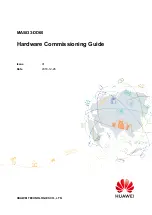
Chapter 5
| Network Connections
Cable Labeling and Connection Records
– 27 –
Cable Labeling and Connection Records
When planning a network installation, it is essential to label the opposing ends of
cables and to record where each cable is connected. Doing so will enable you to
easily locate inter-connected devices, isolate faults and change your topology
without need for unnecessary time consumption.
To best manage the physical implementations of your network, follow these
guidelines:
◆
Clearly label the opposing ends of each cable.
◆
Using your building’s floor plans, draw a map of the location of all network-
connected equipment. For each piece of equipment, identify the devices to
which it is connected.
◆
Note the length of each cable and the maximum cable length supported by the
switch ports.
◆
For ease of understanding, use a location-based key when assigning prefixes to
your cable labeling.
◆
Use sequential numbers for cables that originate from the same equipment.
◆
Differentiate between racks by naming accordingly.
◆
Label each separate piece of equipment.
◆
Display a copy of your equipment map, including keys to all abbreviations at
each equipment rack.
















































